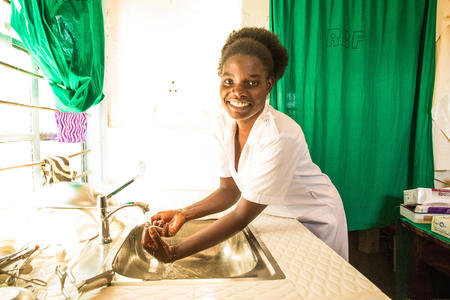World Patient Safety Day: to do no harm we need a revolution in healthcare

Clean water, decent sanitation and good hygiene are fundamental to quality healthcare facilities. Yet one in four lack basic water, one in five lack basic sanitation and almost half don't have handwashing points where needed. On the first World Patient Safety Day, Leah Richardson and Alison Macintyre highlight the need to act on the World Health Assembly resolution on healthcare facilities.
Do no harm. It sounds simple. The concept, as it is used in medical care, is also an old one – ‘primum non nocere’, as it is termed in Latin, forms part of the Hippocratic oath that medical students take as they embark on their medical career. Then why, in 2019, are we marking the first World Patient Safety Day?
We might hope that it is a celebration to mark the progress in achieving that basic Hippocratic oath; a day to recognise how the global health community has progressed in ensuring that everyone who accesses medical care safely receives the treatment they need, without fear of negative consequences.
Sadly, that is not the case. While progress has been reported in patient safety in recent years, World Patient Safety Day in 2019 is not a celebration; it is a wake-up call. For WaterAid, it is a day to call for a revolution in healthcare – a revolution that needs to start with water, sanitation and hygiene (WASH).
WASH are essential but seriously lacking in healthcare centres
For as long as the Hippocratic oath has been around, so has a basic understanding of the need for water to uphold human health. However, the speed at which medical advances have been made in that time far outpaces the rate at which access to basic water and sanitation has been achieved. This year, WHO and UNICEF released the first baseline assessment on water, sanitation and hygiene in healthcare facilities to track progress on the Sustainable Development Goals. It found that one in four health facilities globally do not have basic water services. One in five do not have basic sanitation and close to half do not have points for hand hygiene where treatment is given.
These statistics tell us that we have failed; we are doing harm. We are doing harm when healthcare staff are not able to keep their patients safe and prevent the spread of diseases because basic infrastructure to wash their hands isn’t there. This risk of spreading infections also means spreading antimicrobial resistance, which results in patients staying in hospital longer, needing more treatment and having a higher risk of dying.
We get it – it is shocking to think that a quarter of hospitals and health centres across the globe don’t have a functional water supply on site. How did we get this so wrong? Where do we start to change it? Fortunately, although the data is new, the solutions are not.
WASH in healthcare facilities reduces the risk of infection and spread of superbugs
In May, countries at the World Health Assembly unanimously agreed to a resolution on WASH in healthcare facilities as part of patient safety. It stated ‘that the provision of safe water, sanitation and hygiene services is fundamental for patient safety and has been shown to reduce the risk of infection for patients, carers, health workers’.
The resolution also drew direct links to the global action plan on antimicrobial resistance. This highlights that not only can WASH improve patient safety at the time an individual patient seeks care, but that it has longer term impacts as well. If WASH and infection prevention and control are upheld in healthcare facilities, infections overall decrease, reducing the need for antibiotics, which in turn curbs antimicrobial resistance. This will have long-lasting health and economic benefits for populations everywhere.
We have solutions; now we need political will
Last week, WHO and UNICEF led a global event on WASH in healthcare facilities that brought countries and partners together to share progress and make commitments to kick-start the long overdue revolution. The meeting saw governments make ambitious commitments and partners share technical experiences of what works. We have solutions; we know what we need to do. What is now needed is political will at the highest levels, funding to sustainably change health systems to address WASH facilities, and commitment from all, including patient safety leaders and implementers, to drive change.
World Patient Safety Day presents a perfect occasion for us to mobilise around the resolution from the World Health Assembly. This is the first WHO campaign to create awareness of patient safety, and, as such, should start with the basics. The resolution is a start, not an end. This day should be a powerful push for us to move from resolution to revolution. The basics have been neglected for too long, and, without getting them right, we will undermine other efforts to ensure safe care. Without getting them right, we can never live up to the concept of do no harm.
Alison Macintyre is Health Technical Lead at WaterAid Australia @al_macintyre and Leah Richardson is WASH and Health Advisor at WaterAid Sweden.
About World Patient Safety Day
In May 2019 WHO established a World Patient Safety Day to raise global awareness of patient safety in healthcare. The first World Patient Safety Day is 17 September 2019.
Also read The Lancet’s call for getting the basics right to ensure patient safety.




